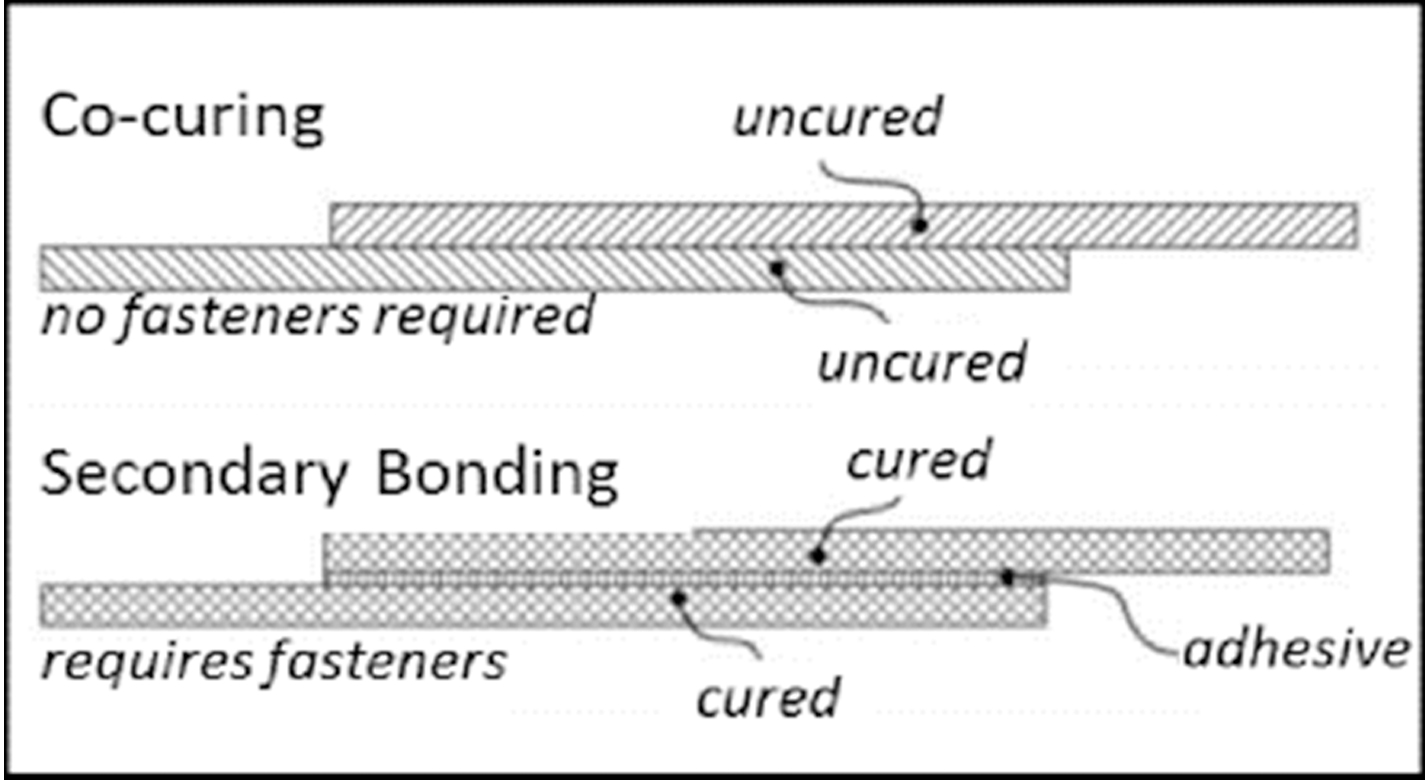Blocking/Deblocking Resin Systems
Manufacturing
Blocking/Deblocking Resin Systems (LAR-TOPS-249)
Blocking/deblocking resin systems for use as a "co-cure-ply" in the fabrication of large-scale composite structures
Overview
Similar to resin systems currently used in composites for aerospace structural applications such as toughened epoxies, this innovation is a modification to traditional resin chemistry to prevent polymerization and crosslinking of the resin when heated and pressed in an autoclave or other common resin curing system. The chemical modification uses blocking groups to block the reactive functional groups in the resin to prevent curing reactions from completing. The blocking groups can be removed by one of several means. Once deblocked, the resin can be cured in an identical manner to an unmodified resin system. The resulting structure is one continuous part without the need for additional fasteners.
The Technology
This technology enables the fabrication of co-cured structures without the need for an autoclave or oven large enough to contain the full-scale structure. Instead, sub-components can be prepared in a less expensive, smaller autoclave or oven with co-cure plys applied to the faying surfaces. A continuous, assembled structure can be prepared using a subsequent curing process in a heated press. The co-cured structures can be designed to meet FAA certification criteria for composite structures because no adhesive bond or mechanical fasteners are needed. The structure can be treated as a single, joint-free component.


Benefits
- Represents an excellent opportunity to streamline a complex and expensive process and reduce cost
- May well fulfill an unmet market need
- The market for this technology may be quite large and may actually have unforeseen applications
Applications
- Presents promising applications in several industries such as: - General Aviation - Automotive - Marine - High speed rail - Wind turbines - 3D printing
- Initially for aircraft applications, especially for manufacture of fuselage parts
Similar Results

Advanced Isothermally Produced Next-Gen Composites
Next generation aircraft are anticipated to be largely made with composite components, requiring significant increases in manufacturing rates of composites to meet the demand for a new fleet of aircraft. The higher rate manufacturing will require multiple advances, including rapid curing and lower processing temperatures. These requirements can be enabled by new processing methods such as isothermal rapidly cured composite parts.
NASA has developed materials and methods that meet those stringent requirements for high-rate manufacturing. The innovators have demonstrated at least two families of new resin formulations that meet the expected high-rate manufacturing needs. These new formulations have been engineered to be infused and cured at the same (i.e., isothermal) temperature, below that of commercially available materials. The materials can then be removed from the mold while still hot without distorting the shape, thereby reducing the processing times by eliminating the need for cooling to occur in the mold. After a post-cure process - which takes 4 hours or less and can be performed in batches - the mechanical properties of NASA's next-gen composites.
The related patent is now available to license. Please note that NASA does not manufacturer products itself for commercial sale.

AERoBOND: Large-scale Composite Manufacturing
This technology (AERoBOND) enables the assembly of large-scale, complex composite structures while maintaining predictable mechanical and material properties. It does so by using a novel barrier-ply technology consisting of an epoxy resin/prepreg material with optimal efficiency, reliability, and performance. The barrier-ply materials prevent excessive mixing between conventional composite precursors and stoichiometrically-offset epoxy precursors during the cure process by forming a gel early in the cure cycle before extensive mixing can occur. The barrier ply is placed between the conventional laminate preform and the stoichiometrically-offset ply or plies placed on the preform surface, thus preventing excessive mass transfer between the three layers during the cure process. In practice, the barrier ply could be combined with the offset ply to be applied as a single, multifunctional surfacing layer enabling unitized assembly of large and complex structures. The AERoBOND method is up to 40% faster than state-of-the-art composite manufacturing methods, allows for large-scale processing of complex structures, eliminates the potential for weak bond failure modes, and produces composites with comparable mechanical properties as compared with those prepared by co-cure.

AERoBOND+ for Manufacturing Composite Structures
The AERoBOND and AERoBOND+ technologies are composite resin materials design innovations that enable new methods for composites joining and manufacturing. The resins are formulated with carefully selected off-set stoichiometries to delay/control the cure such that initial curing of individual components can be followed separately by joining/curing of components together. The ability to delay and control the co-cure joining step provides ease of manufacturing of multi-part composite structures, without compromising joint integrity. There are significant cost savings associated with eliminating fasteners and joint surface preparation steps. To date, the focus of the NASA development effort has been on novel epoxy-based prepreg formulations though other types of thermosets could be considered as well.
The AERoBOND+ innovation provides an added adhesive layer to the AERoBOND joint design to improve the ability to join composite surfaces when these surfaces are less tightly matched. Conventional adhesives, e.g., film, paste, etc., are employed. By including an adhesive between the offset stoichiometric prepreg plies, the adhesive can fill the gaps between the bonding surfaces while maintaining reflowable AERoBOND layer interfaces. Since all interfaces are reflowable, they are much more tolerant of surface contamination, thereby mitigating a primary challenge for conventional adhesive bonding.

Resin Transfer Molding (RTM) 370 Resin for High-Temperature Applications
RTM370 imide resin was developed to address the limitations of conventional imide resins, which are generated from commercially available symmetrical biphenyl dianhydride and oxydianiline (ODA). These resins form symmetrical dianhydride or diamine compounds that result in a substance with much higher viscosity than is viable for RTM, RFI, and VARTM. RTM370 harnesses the unique properties of asymmetric biphenyl dianhydride (a-BPDA) used in combination with a kinked ODA and a 4-(Phenylethynyl) phthalic anhydride endcap to form a mixture that can be melted without the use of solvents, and achieve the desired low-melt viscosity. RTM370 displays a high softening temperature (Tg = 370°C) and can be melted at 260-280°C. It can then be injected into fiber preforms under pressure (200 psi) or through a vacuum (VARTM) to form composites with excellent toughness. The resin can also be made into powder prepregs by melting the resin powders so that they fuse onto fibers. Recently, carbon fiber filled RTM370 imide resins have been fabricated into composites by laser sintering. This exciting advancement in additive manufacturing represents a new frontier for high-temperature composites.
Not only are RTM370 composites lightweight, durable, and impact-resistant, they also possess outstanding abrasion resistance and significant thermo-oxidative stability (as demonstrated in long-term isothermal aging at 288°C for 1,000 hours). In summary, this groundbreaking approach yields a vastly superior resin for fabricating high-quality composites with improved performance, durability, and adaptability. RTM370's unique, solvent-free melt process is simpler, more environmentally friendly, and more cost-effective than competing systems, lending it broad appeal for a variety of Earth-based applications.

Fabrication of Fiber-Metal Laminates with Non-Autoclave Processes
The FMLs resulting from the NASA process have similar properties to traditionally produced metal/composite hybrid laminates including, as compared to either the composite or metal only structures, improved load carrying capability, lighter weight, improved stiffness, improved impact resistance and damage tolerance, and improved permeation resistance. The NASA process can be applied to various FML types, including GLARE (glass, aluminum, epoxy), and TIGR (titanium, graphite). Typical manufacturing processes are costly and complex shapes are hard to produce, whereby the NASA process enables use of these kinds of laminates without an autoclave or press, thus increasing the size that can be produced and decreasing the cost.
The resin pathways in the foils enable connection between the plies that can improve the interlaminar strength of the final part. Functionally the NASA process creates resin columns in the transverse direction of the plies. NASA is working to optimize the final properties by varying the size and distribution of the pathways.



